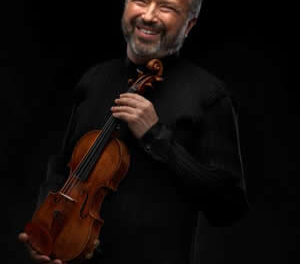Impresario John O’Brien has pulled together the Music House String Quartet, consisting of Kirsten Swanson and John O’Brien, violins; Meredith Harris, viola; and Christopher Nunnally, cello. Yes, there’s O’Brien’s name twice in the same line, for although keyboard (harpsichord, fortepiano, piano, and organ) first comes to mind as O’Brien’s instrument, much of his early training was in strings and he has continued that throughout his life. It is extremely important to note that these players all have strong connections to Greenville. Swanson is a native and was taught by Jon Shaw and Joanne Bath. Harris, also a native, was taught by Ara Gregorian and Joanne Bath. Nunnally is a Greenville native as well and directs the West Side Strings School. O’Brien, though not a native, made Greenville his place of residence, but also his home; his music has enriched the area, and his decisions about buying and enlarging the Music House have enriched thousands of attendees at concerts there. Over 120 years, the Music House has only been in two families, the Moyes and John O’Brien.
Beethoven wrote his Razumovsky quartets for the eponymous Russian ambassador in Vienna. Like his tempestuous life, these quartets are much more rambunctious than any previous. The first movement of Op. 59 No. 9 in C played here tonight, could easily stand alone. The movement begins somberly, slowly, and stately, but at the shift from Andante to Allegro Vivace the quartet attacked with fire and brimstone, thunder and lightning. The vigorous pace begun by first violinist Swanson was ably picked up and sustained by her colleagues. Nunnally was on a little podium of his own with his head at head level of the others, who played standing. His vigor and enthusiasm were delightful. Equally delightful were the hand-offs of the rollicking melody in the bass to the viola; Nunnally was a great pitcher and Harris an equally great catcher. The transitions were flawless, as indeed they were between all the players. After the first movement, there was generous applause. O’Brien had pointed out in his brief introductory remarks that it would be okay to applaud here, as the succeeding three movements are best perceived as almost one seamless piece.
In his introduction, O’Brien had admitted he was nervous, saying that he had discovered that the second violin part had turned out to be harder than he had remembered from playing it as a teenager. O’Brien is famous for his relaxed approach at the keyboard. Whatever his nerves, his playing was precise and enthusiastic.
The third movement, no simple thing, nevertheless provided a little emotional release from the intensity of the preceding, with hints of more intensity to follow. And follow it did, in a great big fugal movement, begun by the viola. Harris had complete command of her instrument. All the players were watching each other, playing for each other; the audience was privileged to watch and listen.
Beethoven is a far cry from Mozart and the jolly music of Handel or Vivaldi; Beethoven is filled with a certain anger, anxiety, and command. However, the whole quartet was one to immerse oneself in.
Claude Debussy’s Opus 10 of 1893 is just as powerful, but very different. The G-minor tonality makes this a little more dolorous than the Beethoven, but still quite pleasant. The contrast between the tense anger of the Beethoven and the relaxed lushness of the Debussy was marked. The quartet’s handling was even and skilled throughout.
The return of regular events at the glistening and enhanced Music House is important to the region; this showcasing of what good things can come out of Greenville was neither a surprise nor an eye-opener, just one more reminder of the contributions being made to the arts by the extended ECU community.











